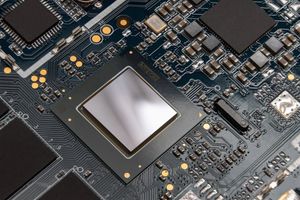
U.S. stock futures are trending upwards, signaling a continuation of the positive momentum that saw the Dow Jones Industrial Average (DJIA) clinch its third straight winning session on Tuesday, November 25, 2025. This surge reflects a market cautiously optimistic about the prospect of a Federal Reserve interest rate cut in December, even as economic data presents a mixed picture. The immediate aftermath of the Dow's robust performance, which added over 664 points, has injected a renewed sense of confidence into investors, pushing broader market indexes like the S&P 500 and Nasdaq Composite higher as well.
The current rally is largely underpinned by the growing anticipation of monetary policy easing, with traders now assigning an 85% probability to a 25-basis-point rate cut by the Fed. This expectation, coupled with easing Treasury yields and sustained interest in the technology sector—particularly around AI innovations—is fueling the ascent. While the market navigates a holiday-shortened trading week, the collective sentiment points towards a willingness to re-engage with blue-chip and cyclical stocks, indicative of a broader market recovery following earlier November concerns over an "AI bubble."
Detailed Market Dynamics and the Path to Recovery
The latest market upswing saw the Dow Jones Industrial Average (DJIA) (NYSE: ^DJI) soar by 664.18 points, or 1.4%, on Tuesday, closing at 47,112.45 and marking its third consecutive positive session. This robust performance contributed to a 1.9% gain for the Dow over the first two trading days of the holiday-shortened week. The momentum carried into Wednesday, November 26, 2025, with Dow futures climbing to 47,243, while S&P 500 (NYSE: ^GSPC) futures rose to 6,796.50, and Nasdaq (NASDAQ: ^IXIC) futures strengthened to 25,164.25, signaling a potential fourth straight session of advances.
This current bullishness follows a turbulent period earlier in November. The market closed October 2025 with strong gains, with the S&P 500, Nasdaq, and Dow all advancing, extending the Dow's winning streak to six months—its longest since 2018. However, the week of November 17, 2025, witnessed an "indiscriminating sell-off," particularly impacting Artificial Intelligence (AI) technology stocks amidst "bubble bursting" fears. The Volatility Index (VIX) (CBOE: ^VIX) briefly spiked to 28.3, reflecting heightened investor anxiety. A pivotal shift occurred between November 21-24, 2025, when expectations for a December Federal Reserve rate cut dramatically surged from 40% to 79-85% following dovish comments from New York Fed President John Williams. This shift provided the primary catalyst for the market's recent rebound.
Key players driving and reacting to these market movements include the Federal Reserve (FOMC), whose monetary policy decisions are paramount. Officials like New York Fed President John Williams significantly influence market sentiment through their public statements. Major technology companies and AI hyperscalers such as Nvidia (NASDAQ: NVDA), Alphabet (NASDAQ: GOOGL), Meta Platforms (NASDAQ: META), Amazon (NASDAQ: AMZN), and Microsoft (NASDAQ: MSFT) remain central to market dynamics, with their earnings, capital expenditures, and innovation dictating significant sector movements. Investors and traders, along with financial analysts from institutions like Bank of America (NYSE: BAC) and Deutsche Bank (NYSE: DB), also play crucial roles in shaping the market's trajectory.
Initial market reactions on Wednesday, November 26, 2025, have been overwhelmingly positive, characterized by a "risk-on" environment. However, this optimism is tempered by the memory of the recent volatility and ongoing scrutiny over tech valuations. While strong corporate results from some sectors have bolstered confidence, concerns persist about the aggressive capital expenditure plans and mounting debt issuance from major hyperscalers, alongside the sustainability of rapid AI growth and the clear path to profitability for many AI-linked firms. The market is thus balancing hopes for economic easing with a cautious eye on tech sector sustainability.
Companies Navigating the Shifting Tides: Winners and Challengers
The current market environment, characterized by rising stock futures, the Dow's sustained gains, and the strong likelihood of a Federal Reserve rate cut, creates distinct opportunities and challenges for public companies. Growth-oriented sectors, particularly technology and consumer discretionary, stand to benefit significantly. Companies like Alphabet (NASDAQ: GOOGL), buoyed by its Gemini AI model and robust cloud services, continue to thrive on the AI frenzy and lower borrowing costs. Amazon (NASDAQ: AMZN), with its dual strength in e-commerce and cloud computing (AWS), is poised to gain from increased consumer spending and continued AI infrastructure demand. High-growth entities such as DraftKings (NASDAQ: DKNG) and Datadog (NASDAQ: DDOG), which leverage AI-native platforms, are also expected to see substantial upside as IT budgets unlock and consumer discretionary spending rises. Even traditional retailers like Urban Outfitters (NASDAQ: URBN) are showing strong performance, indicating a favorable consumer environment.
The AI sector remains a primary driver, with companies at the forefront of innovation poised for continued success. Microsoft (NASDAQ: MSFT), through its strategic investments in OpenAI and its Azure AI platform, has solidified its position as an enterprise AI leader, with its Copilot suite revolutionizing productivity. Nvidia (NASDAQ: NVDA), despite facing increasing competition and valuation scrutiny, continues to be a major beneficiary of the soaring demand for AI chips. Similarly, Dell Technologies (NYSE: DELL) has reported record orders for its AI servers, underscoring the robust demand for underlying AI infrastructure. Cyclical stocks, including industrials, financials, and real estate, are also finding favor. Caterpillar (NYSE: CAT) may see increased demand for heavy machinery, while Home Depot (NYSE: HD) could benefit from enhanced consumer spending on home improvements. Real Estate Investment Trusts (REITs) like FrontView REIT (NYSE: FVR) are direct beneficiaries of rate-cut hopes, as lower rates typically boost real estate investment and affordability. Small-cap companies, often more reliant on debt, will also see improved financial health and growth prospects from reduced borrowing costs.
Conversely, companies struggling to adapt to the rapid advancements in AI or facing direct disruption are at a disadvantage. Intel (NASDAQ: INTC), for instance, has fallen behind rivals in the burgeoning AI chip market, reporting losses and planning job cuts as it struggles to pivot. Traditional software companies with legacy SaaS models may find their offerings disrupted by competitors embedding "agentic AI" that delivers more efficient, end-to-end solutions. Industries with high automation potential, such as manufacturing, retail, and customer service, face significant job displacement, and companies in these sectors that fail to integrate AI effectively into their operations risk higher costs and reduced competitiveness. Highly leveraged companies, even with lower interest rates, could face scrutiny if their growth prospects don't justify their valuations. Furthermore, defensive stocks like utilities (e.g., NextEra Energy (NYSE: NEE)) and consumer staples (e.g., Procter & Gamble (NYSE: PG)), while offering stability, may experience more muted gains as investors rotate into higher-growth opportunities during a broad market rally.
Broader Implications: A Market at a Crossroads
The current market environment in late November 2025, marked by rising stock futures and the Dow's sustained rally, carries significant wider implications for the financial landscape. It underscores a broader industry trend of concentrated market capitalization, where a handful of mega-cap technology companies, particularly those leading the AI revolution, continue to drive a disproportionate share of market gains. This phenomenon can lead to a "K-shaped economy," where leading-edge tech firms flourish while other sectors face increasing pressure. The divergence in sector performance is evident, with AI-driven tech soaring while some software stocks lag despite strong fundamentals, and defensive sectors like healthcare seeing increased interest as investors seek stability amidst tech volatility.
The ripple effects on competitors and partners are substantial. A sustained "Buy The Dip" mentality could further entrench the market leadership of established tech giants, widening the gap with smaller, less capitalized competitors. Conversely, a potential market downturn could trigger a flight to quality, benefiting larger, more stable companies. Companies heavily reliant on AI technology or those within the semiconductor supply chain are under increased scrutiny, with diversification of AI chip suppliers potentially intensifying competition and impacting pricing power for key players like Nvidia (NASDAQ: NVDA). Geopolitical tensions and protectionist trade stances continue to strain global supply chains, encouraging "friend-shoring" and "near-shoring" as nations prioritize security over cost efficiency, which impacts international trade dynamics and capital flows.
From a regulatory and policy perspective, 2025 is anticipated to be a period of potential deregulation, particularly under a new U.S. administration. However, concerns about an "AI bubble" or excessive market concentration could lead to increased regulatory scrutiny on the tech sector. The sustained bull run in cryptocurrency, partly fueled by a dovish Fed, might also attract more regulatory attention regarding market stability and investor protection. Tariff policies, such as the new rounds of U.S. tariff hikes on Chinese imports implemented in January 2025, continue to create economic uncertainty, influencing Federal Reserve decisions and global trade. Fiscal policy, with renewed federal spending following a recent government shutdown, is also seen as supporting the year-end market rally.
Historically, the current AI boom draws parallels to the dot-com bubble of the late 1990s, with a concentration of market capitalization in a few tech stocks, speculative fervor, and high valuations. While today's AI rally is founded on genuine innovation and stronger corporate balance sheets, the rapid appreciation, exemplified by Nvidia's (NASDAQ: NVDA) multi-thousand percent surge, prompts caution, recalling the subsequent collapse experienced by companies like Cisco (NASDAQ: CSCO) post-dot-com era. The Dow's current six-month winning streak also mirrors a similar rally in 2018, providing a recent benchmark for extended market optimism. Periods of rising stock futures coupled with expectations of rate cuts historically signal investor confidence in economic stimulus, though the ultimate outcome depends on underlying economic health and the Federal Reserve's "data-dependent" approach. The market is clearly at a crossroads, balancing the immense potential of AI and economic stimulus with inherent risks and historical lessons.
The Road Ahead: Navigating a Dynamic Market Landscape
Looking ahead, the market in late November 2025 is poised for a complex journey, characterized by both significant opportunities and inherent risks. In the short-term (late 2025 - early 2026), most strategists anticipate continued gains for the S&P 500, with mid-single to low-double-digit returns driven by robust earnings growth and anticipated Federal Reserve rate cuts. JPMorgan, for instance, projects the S&P 500 to hit 7,500 by year-end 2026. However, this period will likely be marked by volatility, with some experts predicting a market pullback of at least 10% due to elevated valuations or a faltering in the AI trade. The global economy is expected to operate in a state of "controlled disorder," balancing geopolitical and inflation risks with the impetus from AI investments and monetary easing.
Longer-term (2026 and beyond), the outlook remains generally optimistic, with forecasts suggesting the S&P 500 could reach 10,000-15,000 by 2030, largely propelled by AI's transformative power. The Dow is also projected to reach the mid-50,000s by 2029. The U.S. economy is expected to remain resilient, growing moderately, but structural risks such as persistent inflation, geopolitical tensions (e.g., US-China rivalry), and fiscal vulnerabilities will persist. A critical development will be the "AI reckoning" in 2026, where the market will increasingly favor businesses that demonstrate clear earnings power directly tied to AI deployment, shifting focus from mere scale to durability and monetization. Conversely, a bear case scenario, fueled by an AI-fueled bubble burst or a deep recession, could lead to a decade of poorer equity returns compared to bonds.
To thrive in this dynamic environment, companies will need to make strategic pivots. Demonstrating clear AI monetization—translating AI investments into tangible earnings and operational efficiencies—will be paramount. This requires significant investment in AI infrastructure, data centers, and cloud computing, while also scrutinizing capital allocation to justify high AI-related expenditures. Companies must also diversify their growth drivers beyond the current mega-cap tech leadership, seeking opportunities in a wider range of sectors and international markets to mitigate concentration risk. Proactive management of geopolitical tensions, such as tariffs and export controls, and navigating potential regulatory scrutiny on AI will also be crucial. Market opportunities include continued robust investment across the entire AI value chain, broadening market participation beyond the "Magnificent Seven," and a boost to rate-sensitive sectors from anticipated Fed cuts. However, challenges include elevated valuations, the risk of an "AI bubble" bursting, monetary policy uncertainty, persistent inflation, and geopolitical instability. The market could follow a base case of moderate bull market with volatility, a bull case of AI-driven euphoria, or a bear case involving a significant correction or recession.
Market Wrap-up: Navigating the New Normal
As late November 2025 draws to a close, the financial markets present a complex tapestry woven with threads of optimism and apprehension. The key takeaway is a market profoundly influenced by the twin forces of anticipated Federal Reserve interest rate cuts and the rapidly evolving Artificial Intelligence sector. Despite the recent positive momentum, with stock futures rising and the Dow notching a significant winning streak, November has proven to be a challenging month for major benchmarks overall. Mixed economic data, including declining consumer confidence and signs of a weaker labor market juxtaposed with rising producer prices, underscore the intricate balancing act facing the Federal Reserve. Geopolitical uncertainties and a moderation in global economic growth further complicate this delicate equilibrium.
Moving forward, market volatility is expected to persist, driven by central bank policy decisions, inflation reports, and ongoing geopolitical developments. While market pullbacks are anticipated, the substantial amount of cash held in money market funds suggests that these dips are likely to be viewed as buying opportunities, reflecting an underlying long-term confidence among investors. The U.S. economy is projected to remain resilient, albeit with a moderated growth trajectory. Earnings growth for the S&P 500 is expected to continue, with the potential for broader participation beyond the concentrated "Magnificent Seven" tech giants. Increased selectivity in investment choices will be paramount in this environment.
This period marks a crucial transition from an era of ultra-low interest rates, with the cost of capital, supply chain resilience, and geopolitical acumen becoming increasingly vital determinants of investment success. The AI revolution is evolving beyond mere speculative hype, demonstrating measurable impacts across the global economy and shifting investor focus from potential to tangible profitability. The interplay of AI dynamics and central bank monetary policies is set to have a profound and lasting impact on investment strategies, sector preferences, and the overall market structure.
For investors in the coming months, vigilance and adaptability will be key. Closely monitor all communications from the Federal Reserve, paying particular attention to statements and speeches from FOMC members for further clues on the trajectory of interest rates. Keep a keen eye on incoming economic data, especially inflation reports (CPI, PPI), labor market indicators (jobless claims, employment figures), and consumer confidence surveys, as these will heavily influence the Fed's decisions. The competitive landscape within the AI sector is rapidly changing; investors should scrutinize developments among major tech players like Google (NASDAQ: GOOGL), Nvidia (NASDAQ: NVDA), AMD (NASDAQ: AMD), and Meta (NASDAQ: META), as shifts in market share and technological advancements will dictate future performance. Diversification within the AI theme, rather than concentrated bets, is advisable. Portfolio diversification across various asset classes, including fixed income (embracing income opportunities), global bonds, and emerging markets, remains paramount. Finally, stay cognizant of geopolitical events and diligently assess corporate earnings and valuations, particularly in sectors that have seen rapid appreciation, to identify sustainable growth opportunities.
This content is intended for informational purposes only and is not financial advice





